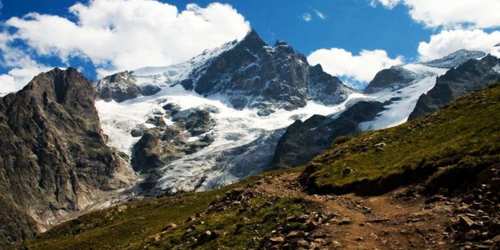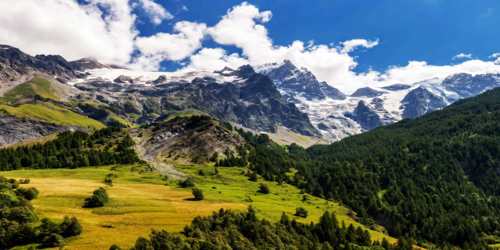Écrins National Park (French: Parc national des Écrins, pronounced – paʁk nasjɔnal dɛz‿ekʁɛ̃) is one of France’s ten national parks. It is located in the south-eastern part of France in the Dauphiné Alps south of Grenoble and north of Gap, shared between the départements of Isère and Hautes-Alpes.
The Ecrins National Park was officially created on 27th March 1973. Its charter, co-written with local partners, is based upon suggested excursions, the welcoming of visitors, and educational initiatives. The perfect destination for hikers, climbers, and mountaineers, Écrins National Park is known for its pristine wilderness which reaches altitudes as high as 4,100 meters. Glaciers and rivers have carved out steep valleys and jagged mountain peaks in the national park, providing plenty of dramatic scenery.
It rises up to 4,102 m (13,458 ft) at the Barre des Ecrins and covers 918 km2 (354 sq mi) of high mountain areas, with high peaks, glacier fields, glacier valleys, alpine pastures, subalpine woodlands, and lakes. Its borders mostly correspond to these of the Massif des Ecrins, delimited by the main valleys of rivers Drac, Romanche, and Durance (with its Guisane dependency).

Écrins National Park covers a central mountainous area of 91,800 hectares ranging in altitude from 800 to 4,102 meters. A favorite destination for nature lovers, this vast unspoiled territory is home to a very rich flora and fauna, including chamois, ibex, golden eagles, foxes, squirrels and marmots, and plants like edelweiss, blue thistle, genépi, and gentian. The Écrins mountains are also a paradise for hikers, with no fewer than 740 km of waymarked footpaths, as well as for climbers: it’s considered the second mountaineering site in France.
Culminating at 4102 meters at the top of the Bar des Ecrins, it is regarded as the European park of tall mountains. Its valleys form marked landscape and cultural identities: Oisans, Valbonnais, Briançonnais, Vallouise, Embrunais, Champsaur, and Valgaudemar. Its astonishing diversity in vegetation is a result of great altitude deviations and the conjugation of climatic influences of the Alps and the Mediterranean. Valleys, mountain pastures, and peaks are home to all the fauna of the mountains.
Écrins National Park attracts up to 800,000 tourists each year. The park has been awarded the European Diploma of Protected Areas.
History of The Park –
The Ecrins National Park was the 5th national park to be classified in France following the creation of the Vanoise, Port-Cros, Pyrénées, and Cévennes national parks.
The need for a protected natural site was recognized in 1913 with the creation of La Bérarde National Park by the Water & Forest Commission; it came about due to the concerns of mountain climbers, the French Alpine Club, and various nature associations.
The history of the area can be charted way back to before the 20th century though; in fact, there are artefacts found in the park that dates back to the Bronze Age! In the centuries that followed generations of people strived to exist in the high mountains of the Ecrins and an agricultural-pastoral civilization flourished. Communities created homes anywhere that was suitable; it had to be accessible, protected from the worst of the elements, free from flood/avalanche risk, and suitable for small scale farming.
A surge in population and development of the land took place in the mid-19th century when a new wave of mountaineers and guides began to explore the natural challenges of this dramatic landscape. The new activity of guiding and catering for visitors took its place alongside agricultural labor as one of the main ways to earn a living.
As in many rural communities, the impact of the 1st and 2nd World Wars had a marked effect on the population of the villages that make up the Ecrins region. The first half of the 20th century saw many people migrate from the countryside to the cities, leaving smaller villages bereft. It is only really within the last few decades that the population has stabilized due to the combination of increased agriculture and the advent of tourism. One of the objectives of the park is to preserve the heritage of the area and learn more about its history.

There is a huge range of activities visitors can do in the park, as long as they respect the regulations and inform themself of the rules before they set out. For first time visitors, the park is well laid out with specially designed nature trails, signposted footpaths, information points, and the Park house. There is a number of guiding and adventure companies in the area that will take visitors hiking, climbing or exploring the waterways there are over 500km of streams, rivers, and waterfalls in which visitors can raft kayak and canyon.
Information Sources:
















